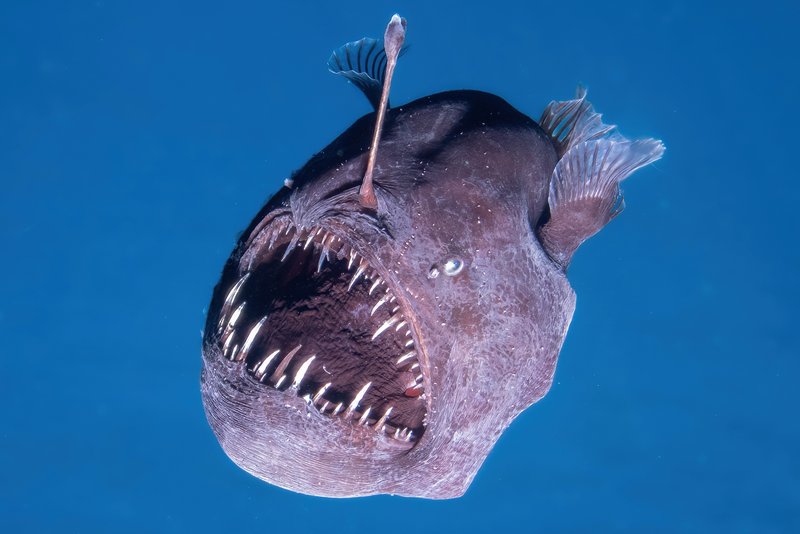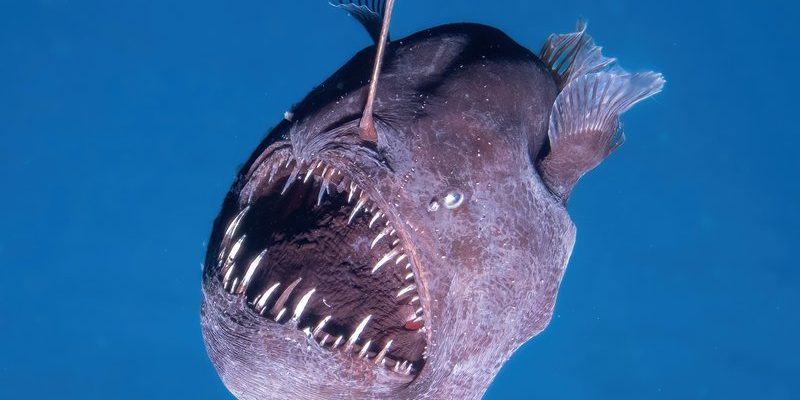
Imagine a fish that uses a glowing lure to catch its prey. Sounds like something out of a sci-fi movie, right? Well, in the depths of the ocean, the anglerfish does just that! This fascinating creature is known for its unique hunting technique and unusual appearance. With a head that looks like it came from a different world, the anglerfish is truly a remarkable example of nature’s ingenuity.
Anglerfish belong to the order Lophiiformes, which includes over 200 species. They primarily inhabit the dark depths of the ocean, usually at depths of 200 meters (656 feet) and beyond. Since they live in such extreme conditions, their adaptations are nothing short of extraordinary. From their bioluminescent lures to their ability to consume prey larger than themselves, anglerfish showcase the many ways life can thrive in the deep sea.
One of the most striking features of anglerfish is the bioluminescent lure that protrudes from their heads. This lure, resembling a fishing rod, emits light that attracts unsuspecting prey. When fish come close, they don’t stand a chance. You might think of the anglerfish as a master of disguise, playing the role of both predator and prey in a captivating underwater performance.
Physical Characteristics
Anglerfish come in various shapes and sizes, but they generally have some common features. Their bodies tend to be flattened, with a wide mouth full of sharp teeth. Some species can grow to be quite large, with the largest known anglerfish, the Himantolophus groenlandicus, reaching lengths of up to 1.2 meters (4 feet). However, many species are much smaller, typically measuring around 20 to 30 centimeters (8 to 12 inches).
Their skin ranges from brown to dark purple, often with a rough texture. A unique feature of anglerfish is their ability to change color slightly, helping them blend into their surroundings. This camouflaging ability is crucial for their survival, allowing them to hide from predators while waiting to ambush unsuspecting prey.
One of the most remarkable aspects of anglerfish is their lure, which contains bioluminescent bacteria. This glow can be blue or green, providing an enticing light that draws in curious creatures of the deep. When a prey fish swims too close, the anglerfish can quickly snap its mouth shut, capturing its dinner in the blink of an eye. It’s a deadly combination of beauty and efficiency!
Habitat and Distribution
Anglerfish are most commonly found in the dark, cold waters of the ocean, particularly in deep-sea environments. They inhabit continental slopes and ocean depths, where sunlight barely penetrates. This means that anglerfish have evolved to thrive in conditions that many other species cannot tolerate. The darkness of the deep sea is their playground, and they’ve adapted wonderfully to it.
Some species of anglerfish prefer the deep ocean, typically dwelling at depths ranging from 200 to 2,000 meters (656 to 6,561 feet). Others are found in shallower coastal waters. In fact, the monkfish, a type of anglerfish, can often be found in sandy and muddy bottoms close to shore. This adaptability allows anglerfish to occupy diverse niches within their habitat, ensuring their survival in various marine environments.
You might find it interesting that anglerfish are distributed across all oceans, including the Atlantic, Pacific, and Indian Oceans. Their ability to thrive in harsh environments makes them one of the most successful fish groups in the deep sea. Even though they may seem isolated in the depths, anglerfish play an essential role in maintaining the balance of their ecosystems.
Diet and Feeding Behavior
Anglerfish are opportunistic predators, meaning they’ll eat whatever comes their way. Their primary source of food includes smaller fish, crustaceans, and other invertebrates. Thanks to their remarkable hunting strategy, they can take advantage of the limited food supply in their deep-sea habitats.
When it comes to feeding, anglerfish are patient hunters. They sit still and wait for prey to swim close enough to be caught by their lure. Once a fish is attracted by the glowing light, the anglerfish strikes with lightning speed. Their mouths can expand significantly, allowing them to gulp down prey larger than themselves. In fact, some species can consume prey that is almost twice their body size!
The feeding strategy of anglerfish isn’t just about the bright lure; it’s also about their surprising agility. They have a unique structure in their jaw that allows them to latch onto prey quickly, ensuring a successful catch. This combination of lure and speed makes them one of the most efficient hunters of the deep sea, with adaptations that are both fascinating and effective.
Reproduction and Lifespan
Reproduction in anglerfish is as unique as their appearance. Most species exhibit sexual dimorphism, meaning males and females have distinct differences. Male anglerfish are significantly smaller than females, and their primary goal in life is to find a mate. Once they do, things get quite intriguing. Male anglerfish will latch onto the females, fusing their bodies together. Over time, the male becomes a permanent parasite, relying on the female for nutrients.
This extraordinary reproductive strategy allows males to stay close to females, ensuring they can reproduce whenever conditions are right. After mating, females can produce thousands of eggs, which they release into the water. The eggs hatch into tiny larvae that drift with the ocean currents, eventually growing into adult anglerfish.
The lifespan of anglerfish varies by species, with many living anywhere from 10 to 20 years. Some larger species can live even longer! This impressive lifespan allows them sufficient time to adapt to the challenges of life in the deep sea, giving them a better chance of survival in a world that can be both beautiful and brutal.
Unique Adaptations
What makes anglerfish truly remarkable are their unique adaptations to their dark environments. One of the most famous is their bioluminescent lure. This glowing appendage, located on the top of their heads, is not just for show. It’s a sophisticated hunting tool that attracts prey in a world where light is scarce. The lure can even mimic the movements of a small fish or worm, making it even more enticing.
Besides their impressive lure, anglerfish have developed other fascinating adaptations. Their jaws are equipped with highly flexible bones, allowing them to open their mouths wider than most fish. This flexibility enables them to consume larger prey that would be impossible for many other fish to catch. They also have specialized teeth that help hold onto slippery prey, preventing it from escaping once caught.
Another interesting adaptation is their ability to survive on limited food supplies. In the deep sea, food is often scarce, so anglerfish have evolved to go for long periods without eating. They can slow their metabolism dramatically, conserving energy until their next meal swims by. This adaptability is a survival tactic that allows them to thrive in one of the most challenging environments on Earth.
Conservation Status
While anglerfish are fascinating creatures, their conservation status varies by species. Some anglerfish populations are stable, while others face threats from overfishing and habitat destruction. The demand for certain types of anglerfish, particularly in the culinary world, has led to increased fishing pressure on specific species.
The IUCN Red List categorizes different anglerfish species based on their conservation status. For instance, the Monkfish is listed as vulnerable due to overfishing and loss of habitat. Conservation efforts are essential to ensure the survival of these unique creatures. Sustainable fishing practices and habitat protection can help maintain anglerfish populations in the wild.
In recent years, researchers have highlighted the importance of deep-sea ecosystems and the role anglerfish play within them. Protecting these environments is crucial not just for the survival of anglerfish but for the health of the entire marine ecosystem. By understanding and respecting the delicate balance of life in the deep sea, we can help ensure that anglerfish and their habitats thrive for generations to come.
Interesting Facts about Anglerfish
| Size: | 20 cm to 1.2 m (0.8 to 4 ft) |
| Habitat: | Deep ocean, 200 to 2000 m (656 to 6560 ft) |
| Diet: | Small fish, invertebrates |
| Lifespan: | 10 to 20 years, some longer |
| Mating Behavior: | Male fuses with female |
FAQ
How do anglerfish use their lure?
Anglerfish use their bioluminescent lure to attract prey in the dark depths of the ocean. The lure emits light that can resemble other small creatures, making it irresistible to passing fish. This clever strategy allows anglerfish to catch their meals efficiently.
Are all anglerfish bioluminescent?
Not all anglerfish species are bioluminescent, but many are. The ability to produce light is more common among deep-sea species, where darkness prevails. Some anglerfish rely on other hunting techniques if they lack a luminescent lure.
Do anglerfish have any predators?
Yes, anglerfish do have predators. Larger fish, squid, and even some marine mammals prey on anglerfish. However, their ability to blend into their environment and their unique adaptations often help them avoid becoming a meal themselves.
What is the most interesting feature of anglerfish?
The most interesting feature of anglerfish is undoubtedly their bioluminescent lure. This adaptation not only serves as a hunting tool but also showcases the incredible diversity of life in the ocean. The way they can attract prey with a simple glowing light is truly remarkable!
How do anglerfish reproduce?
Anglerfish have a fascinating reproduction method. Males are significantly smaller than females and will latch onto their mates, often becoming a permanent part of the female. This unique strategy ensures that they are always ready to fertilize the female’s eggs when the time comes to spawn.
Do anglerfish live in freshwater?
No, anglerfish are exclusively marine creatures. They thrive in saltwater environments, typically found in the deep sea. There are no known species of anglerfish that live in freshwater habitats.
Can anglerfish see well in the dark?
Anglerfish have adapted to their dark environments, and while they might not have great eyesight compared to some other fish, they are equipped to detect light and movement. Their senses are tailored for life in the deep sea, where visibility is minimal, allowing them to hunt effectively in their surroundings.
What role do anglerfish play in their ecosystem?
Anglerfish play a critical role in their ecosystem as both predators and prey. By controlling the population of smaller fish and invertebrates, they help maintain balance in the marine food web. Their unique adaptations also help to showcase the diversity of life in the deep ocean.

